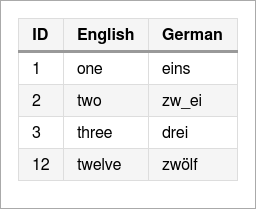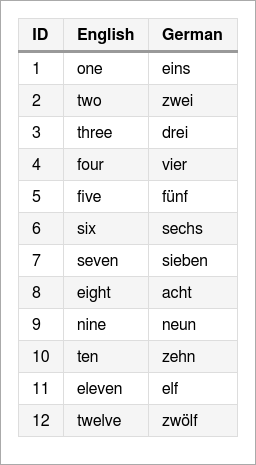Tables
Output a table (data object and optional column object needed). This can be called with different kind of objects making it easy to use nearly everything you have.
Syntax: report.table <object>, <columns>, <sort>, <mask>
The complexest format will be shown at first:
<object> : a list of row maps like returned from a database
<columns> : a map of column id to use as columns with the options:
- title - heading text
- align - orientation (one of 'left', 'center', 'right')
- width - the minimum width of the column (optional)
<sort> : a map of sort conditions defining the column id and order ('asc', 'desc')
<mask> : (boolean) use Report.mask() on each field value
All other formats will be converted into this filling missing information with default values. You may also use the table format which can include the column settings and often is already sorted.
There are lots of ways to use this.
from alinex-table
Simple conversion
CoffeeScript Code table = new Table [
['ID', 'English', 'German']
[1, 'one', 'eins']
[2, 'two', 'zw_ei']
[3, 'three', 'drei']
[12, 'twelve', 'zwölf']
]
report = new Report()
report.table tableMarkdown Document | ID | English | German ||:-- |:------- |:------ || 1 | one | eins || 2 | two | zw_ei || 3 | three | drei || 12 | twelve | zwölf |
And renders as HTML and console output:
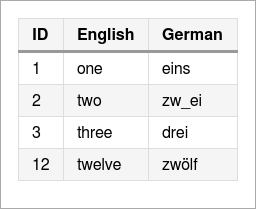
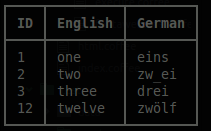
With align settings
CoffeeScript Code table = new Table [
['ID', 'English', 'German']
[1, 'one', 'eins']
[2, 'two', 'zw_ei']
[3, 'three', 'drei']
[12, 'twelve', 'zwölf']
]
table.style null, 'ID', {align: 'right'}
report = new Report()
report.table tableMarkdown Document | ID | English | German || --:|:------- |:------ || 1 | one | eins || 2 | two | zw_ei || 3 | three | drei || 12 | twelve | zwölf |
And renders as HTML and console output:


With mask settings
CoffeeScript Code table = new Table [
['ID', 'English', 'German']
[1, 'one', 'eins']
[2, 'two', 'zw_ei']
[3, 'three', 'drei']
[12, 'twelve', 'zwölf']
]
report = new Report()
report.table table, null, null, trueMarkdown Document | ID | English | German ||:-- |:------- |:------ || 1 | one | eins || 2 | two | zw\_ei || 3 | three | drei || 12 | twelve | zwölf |
And renders as HTML:
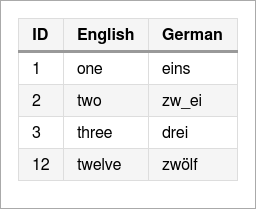
with list-map
CoffeeScript Code table = [
{id: 1, en: 'one', de: 'eins'}
{id: 2, en: 'two', de: 'zwei'}
{id: 3, en: 'three', de: 'drei'}
{id: 12, en: 'twelve', de: 'zwölf'}
]
report = new Report()
report.table tableMarkdown Document | id | en | de ||:-- |:------ |:----- || 1 | one | eins || 2 | two | zwei || 3 | three | drei || 12 | twelve | zwölf |
And renders as HTML and console output:
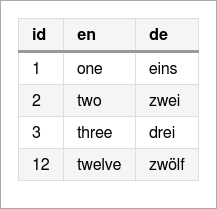
Using column map-map
CoffeeScript Code table = [
{id: 1, en: 'one', de: 'eins'}
{id: 2, en: 'two', de: 'zwei'}
{id: 3, en: 'three', de: 'drei'}
{id: 12, en: 'twelve', de: 'zwölf'}
]
columns =
id:
title: 'ID'
align: 'right'
de:
title: 'German'
en:
title: 'English'
report = new Report()
report.table table, columnsMarkdown Document | ID | German | English || --:|:------ |:------- || 1 | eins | one || 2 | zwei | two || 3 | drei | three || 12 | zwölf | twelve |
And renders as HTML and console output:
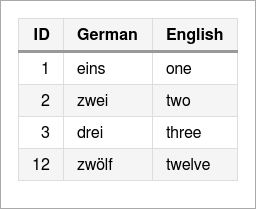
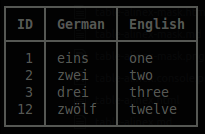
Using column list-map
CoffeeScript Code table = [
{id: 1, en: 'one', de: 'eins'}
{id: 2, en: 'two', de: 'zwei'}
{id: 3, en: 'three', de: 'drei'}
{id: 12, en: 'twelve', de: 'zwölf'}
]
columns = [
['id', 'en']
['ID', 'English']
]
report = new Report()
report.table table, columnsMarkdown Document | ID | English ||:-- |:------- || 1 | one || 2 | two || 3 | three || 12 | twelve |
And renders as HTML:
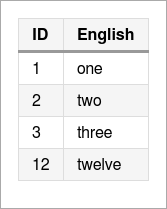
Using column list
CoffeeScript Code table = [
{id: 1, en: 'one', de: 'eins'}
{id: 2, en: 'two', de: 'zwei'}
{id: 3, en: 'three', de: 'drei'}
{id: 12, en: 'twelve', de: 'zwölf'}
]
columns = ['ID', 'English', 'German']
report = new Report()
report.table table, columnsMarkdown Document | ID | English | German ||:-- |:------- |:------ || 1 | one | eins || 2 | two | zwei || 3 | three | drei || 12 | twelve | zwölf |
And renders as HTML:
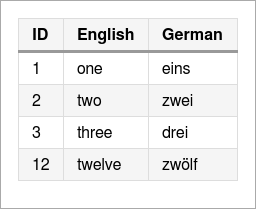
Using column map
CoffeeScript Code table = [
{id: 1, en: 'one', de: 'eins'}
{id: 2, en: 'two', de: 'zwei'}
{id: 3, en: 'three', de: 'drei'}
{id: 12, en: 'twelve', de: 'zwölf'}
]
columns =
id: 'ID'
en: 'English'
report = new Report()
report.table table, columnsMarkdown Document | ID | English ||:-- |:------- || 1 | one || 2 | two || 3 | three || 12 | twelve |
And renders as HTML:

Using sort map
CoffeeScript Code table = [
{id: 1, en: 'one', de: 'eins'}
{id: 2, en: 'two', de: 'zwei'}
{id: 3, en: 'three', de: 'drei'}
{id: 12, en: 'twelve', de: 'zwölf'}
]
columns =
id:
title: 'ID'
align: 'right'
de:
title: 'German'
en:
title: 'English'
sort = {de: 'desc'}
report = new Report()
report.table table, columns, sortMarkdown Document | ID | German | English || --:|:------ |:------- || 12 | zwölf | twelve || 2 | zwei | two || 1 | eins | one || 3 | drei | three |
And renders as HTML:
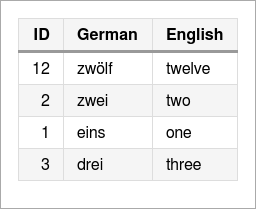
Using sort list
CoffeeScript Code table = [
{id: 1, en: 'one', de: 'eins'}
{id: 2, en: 'two', de: 'zwei'}
{id: 3, en: 'three', de: 'drei'}
{id: 12, en: 'twelve', de: 'zwölf'}
]
columns =
id:
title: 'ID'
align: 'right'
de:
title: 'German'
en:
title: 'English'
sort = ['de']
report = new Report()
report.table table, columns, sortMarkdown Document | ID | German | English || --:|:------ |:------- || 3 | drei | three || 1 | eins | one || 2 | zwei | two || 12 | zwölf | twelve |
And renders as HTM:
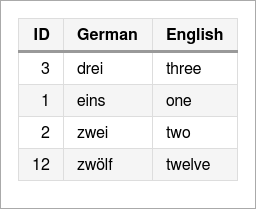
Using sort key
CoffeeScript Code table = [
{id: 1, en: 'one', de: 'eins'}
{id: 2, en: 'two', de: 'zwei'}
{id: 3, en: 'three', de: 'drei'}
{id: 12, en: 'twelve', de: 'zwölf'}
]
columns =
id:
title: 'ID'
align: 'right'
de:
title: 'German'
en:
title: 'English'
sort = 'de'
report = new Report()
report.table table, columns, sortMarkdown Document | ID | German | English || --:|:------ |:------- || 3 | drei | three || 1 | eins | one || 2 | zwei | two || 12 | zwölf | twelve |
And renders as HTML:
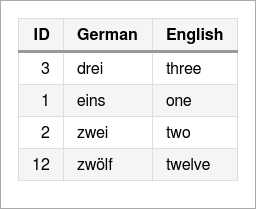
with list array
CoffeeScript Code table = [
[1, 'one', 'eins']
[2, 'two', 'zwei']
[3, 'three', 'drei']
[12, 'twelve', 'zwölf']
]
report = new Report()
report.table tableMarkdown Document | 1 | one | eins ||:-- |:------ |:----- || 2 | two | zwei || 3 | three | drei || 12 | twelve | zwölf |
And renders as HTML:

Using column list
CoffeeScript Code table = [
[1, 'one', 'eins']
[2, 'two', 'zwei']
[3, 'three', 'drei']
[12, 'twelve', 'zwölf']
]
columns = ['ID', 'English', 'German']
report = new Report()
report.table table, columnsMarkdown Document | ID | English | German ||:-- |:------- |:------ || 1 | one | eins || 2 | two | zwei || 3 | three | drei || 12 | twelve | zwölf |
And renders as HTML:

Using column list-array
CoffeeScript Code table = [
[1, 'one', 'eins']
[2, 'two', 'zwei']
[3, 'three', 'drei']
[12, 'twelve', 'zwölf']
]
columns = [
[0, 1]
['ID', 'English']
]
report = new Report()
report.table table, columnsMarkdown Document | ID | English ||:-- |:------- || 1 | one || 2 | two || 3 | three || 12 | twelve |
And renders as HTML:

Using column list-map
CoffeeScript Code table = [
[1, 'one', 'eins']
[2, 'two', 'zwei']
[3, 'three', 'drei']
[12, 'twelve', 'zwölf']
]
columns = [
title: 'ID'
align: 'right'
,
title: 'English'
,
title: 'German'
]
report = new Report()
report.table table, columnsMarkdown Document | ID | English | German || --:|:------- |:------ || 1 | one | eins || 2 | two | zwei || 3 | three | drei || 12 | twelve | zwölf |
And renders as HTML:

With empty fields
CoffeeScript Code table = [
[1, 'one', 'eins']
[2, '', 'zwei']
[3, null, 'drei']
[12, undefined, 'zwölf']
]
report = new Report()
report.table tableMarkdown Document | 1 | one | eins ||:-- |:--- |:----- || 2 | | zwei || 3 | | drei || 12 | | zwölf |
And renders as HTML:

with map
CoffeeScript Code table =
id: '001'
name: 'alex'
position: 'developer'
report = new Report()
report.table tableMarkdown Document | Name | Value ||:-------- |:--------- || id | 001 || name | alex || position | developer |
And renders as HTML:

Using volumn list
CoffeeScript Code table =
id: '001'
name: 'alex'
position: 'developer'
report = new Report()
report.table tableMarkdown Document | NAME | VALUE ||:-------- |:--------- || id | 001 || name | alex || position | developer |
And renders as HTML:

With list and object content
CoffeeScript Code table =
number: [1..8]
name: 'alex'
data:
type: 'developer'
lang: 'javascript'
report = new Report()
report.table tableMarkdown Document | Name | Value ||:--------- |:---------------------- || number | 1, 2, 3, 4, 5, 6, 7, 8 || name | alex || data.type | developer || data.lang | javascript |
And renders as HTML:
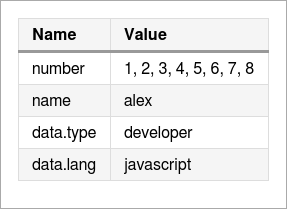
Interactive Table
Instead of simple tables for the HTML output they may be made interactive, allowing:
- sorting
- filtering
- paging
All these may be done by the user. But if such tables are outputted to other format they will only show a normal table. It is also not possible to run this in most mail clients (only if attached and opened in Browser).
CoffeeScript Code report = new Report()
report.datatable new Table([
['ID', 'English', 'German']
[1, 'one', 'eins']
[2, 'two', 'zw_ei']
[3, 'three', 'drei']
[12, 'twelve', 'zwölf']
])The possible options to give as second parameter are documented at the jQuery datatable. The default will disable paging, search and info.
As markdown this will be written as three separate elements working together:
Markdown Document | ID | English | German |
|:-- |:------- |:------ |
| 1 | one | eins |
| 2 | two | zw_ei |
| 3 | three | drei |
| 12 | twelve | zwölf |<!-- {table:#datatable1} -->
$$$ js
$(document).ready(function () {
$('#datatable1').DataTable({
"paging": false,
"info": false
});
});
$$$And finally in HTML this will look like (click to show working HTML):
Features
In this example a lot of features are activated:
- info - (boolean) show information about the table including information about filtered data (default: false, true in markdown)
- paging - (boolean) set to true to enable paging of data (default: false, true in markdown)
- lengthChange - (boolean) control the end user’s ability to change the paging display length of the table if paging is enabled (default: true)
- ordering - (boolean) control ordering/sorting abilities in table (default: true)
- searching - (boolean) control search/filtering abilities (default: false, true in markdown)
- scrollX - (boolean) enable horizontal scrolling if necessary for viewport
- scrollY - (boolean) enable vertical scrolling if necessary for viewport
CoffeeScript Code report = new Report()
report.datatable new Table([
['ID', 'English', 'German']
[1, 'one', 'eins']
[2, 'two', 'zwei']
[3, 'three', 'drei']
[4, 'four', 'vier']
[5, 'five', 'fünf']
[6, 'six', 'sechs']
[7, 'seven', 'sieben']
[8, 'eight', 'acht']
[9, 'nine', 'neun']
[10, 'ten', 'zehn']
[11, 'eleven', 'elf']
[12, 'twelve', 'zwölf']
]),
info: true
paging: true
searching: trueAs markdown this will be written as follows:
Markdown Document | ID | English | German |
|:-- |:------- |:------ |
| 1 | one | eins |
| 2 | two | zwei |
| 3 | three | drei |
| 4 | four | vier |
| 5 | five | fünf |
| 6 | six | sechs |
| 7 | seven | sieben |
| 8 | eight | acht |
| 9 | nine | neun |
| 10 | ten | zehn |
| 11 | eleven | elf |
| 12 | twelve | zwölf |<!-- {table:#datatable1} -->
$$$ js
$(document).ready(function () {
$('#datatable1').DataTable({
"info": true,
"paging": true,
"searching": true
});
});
$$$And finally in HTML this will look like (click to show working HTML):
